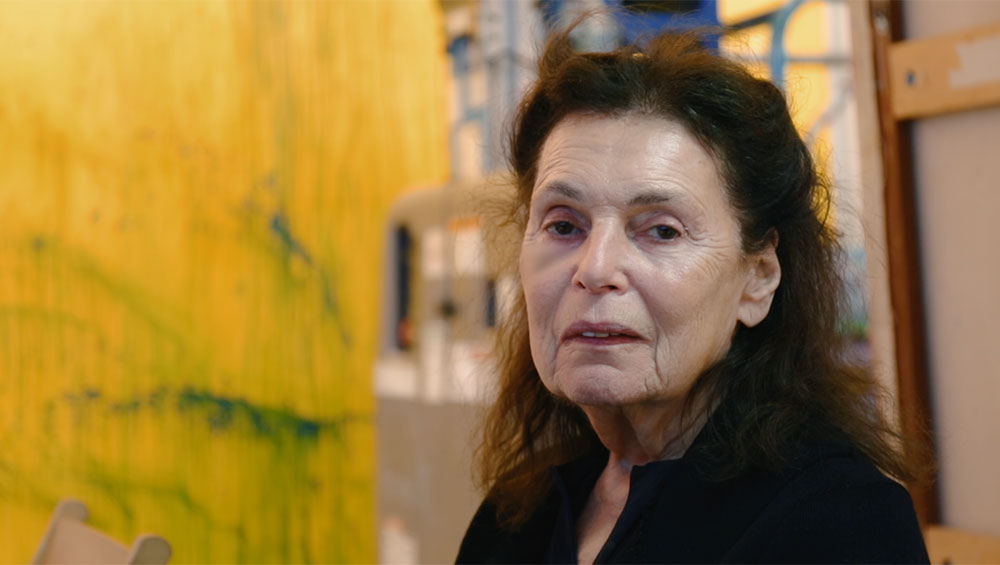
by LILLY WEI
Author and film-maker Veronica Gonzalez Peña’s recently released documentary, with its straight-up title, Pat Steir: Artist (2019), is now available on multiple streaming platforms. The film itself is far less plain than its title. A poetic, empathetic portrait of the New York-based painter who is sometimes referred to as a conceptual abstractionist, it is also more wayward, more inflected than the usual artist profile. For one thing, it does not dwell on Steir’s personal life – with the exception of the artist’s reflections on her childhood and her parents – but it nonetheless fosters intimacy and, at its conclusion, we feel that we’ve come to know the artist well.
The engaging, lushly filmed production – the colour is dazzling – took about four years to complete, beginning, Steir said, sometime in 2016. Gonzalez Peña’s camera follows the artist attentively, even tenderly, constructing an arresting, faceted portrayal in the round by circling her from multiple points in time and space, the film radiating outward non-chronologically from the present, the artist at its centre. Steir is no artist in a garret: we are shown her historic, multi-storied West Village home and her very personal collection of art, the work by close friends such as Bernd and Hilla Becher, Kiki Smith, Robert Mangold and Sol LeWitt, as well as some of her own earlier work. We linger with her in her garden, a secret Arcadia invisible from the street, and we watch her, up on a lift, painting on panoramic canvases tacked directly to the walls of her immense Chelsea studio. She takes us for a proprietary walk through her downtown environs, heading south to Little Italy and Chinatown. And we accompany her as she goes to art exhibitions and events, to the Lower East Side, uptown to the Guggenheim, Madison Avenue and upstate, to architect Steven Holl’s elegant exhibition space. Again, unusual for such a profile, the focus shifts for a substantive amount of time to a select triumvirate of artists whose impact on Steir has been immeasurable: composer John Cage, conceptualist LeWitt and minimalist Agnes Martin, who talk about their own art and process. Steir then analyses their work, refreshing the usual (and too often tedious) talking-heads formula.
It is an overview of decades, of flashbacks, recollections and the present, recounted with unscripted candour by the artist. It flashes childhood pictures and unrolls footage of her as a striking, articulate and fearless young artist in New York. We see her in her middle years and now, at 80. The narrative is associative, moments in and out of time. One thought leads to another, building on another, the artist given free rein, or so it seems.
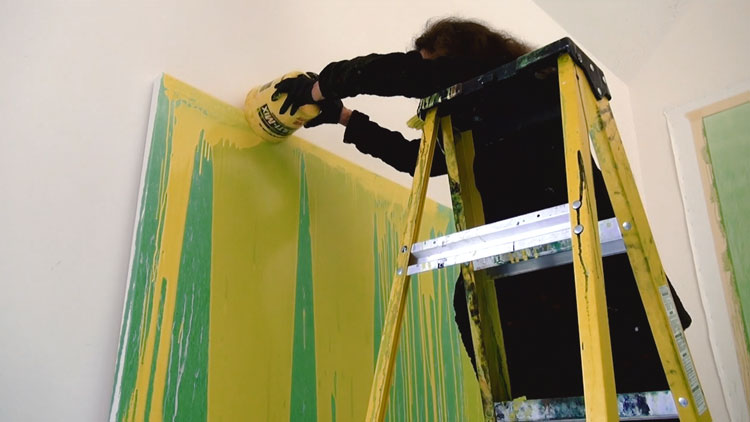
Pat Steir working in her studio. Photo: Molly Davies.
Steir is fully capable of carrying the film as a one-woman performance, as evidenced here. Perhaps one of the last of the grandes dames of the New York art world, she is a cosmopolite who is also the personification of a New York artist. In the film, she tells us, matter-of-factly, that she has always been intrepid, a feminist who equates feminism with survival.
Interest in her work has soared of late, greater even than the acclaim she received early in her career. Among other tributes, she has had three museum shows in the past two years – one at the Hirshhorn Museum and Sculpture Garden in Washington DC, another at the Barnes Foundation in Philadelphia, and another at the New Orleans Museum of Art – as well as solo exhibitions in New York and London at Lévy Gorvy, the gallery that represents her. In a conversation with Steir in July, we discussed the film, her work and some of her thoughts about art over the years. This is an edited version of that conversation.
Lilly Wei: Could you tell me how the film that Veronica Gonzalez Peña made about you came about?
Pat Steir: I met Veronica at a dinner for my friend the poet Mei-mei Berssenbrugge. She was making a feature film and asked me to be in it. And some time after that, she asked if she could make a documentary about me. That was around four years ago.
LW: One of the reasons I thought it was an exceptional documentary, an exceptional portrait of an artist, was its sense of intimacy, and how it seemed so natural, so unstructured. It was very personal, although the film was not about your personal life, except for your childhood, which you talk about with remarkable objectivity. It was clear you two had established a strong rapport.
PS: Yes, we became close during the making of the film. I don’t know that I meant to tell her all that, but she makes it easy to talk to her. Veronica is responsible for the openness.
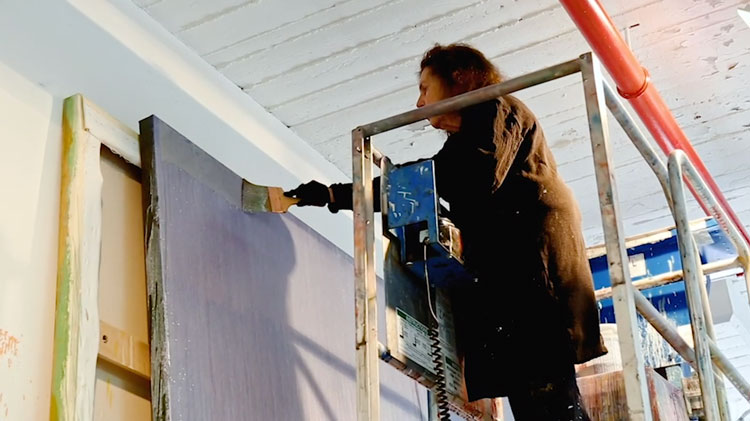
Pat Steir working in her studio on Lila Judith, 2016–17. Photo courtesy Pat Steir and Veronica Gonzalez Peña.
LW: How much input did you have in the creation of the film?
PS: I didn’t interfere at all. It was all her.
LW: It focused on you for nearly the entire film. The inclusion of artists and the works of artists such as John Cage, Sol LeWitt and Agnes Martin, all of whom you knew and were important to you, was introduced so organically that they were integral to the narrative. One particularly satisfying sequence was the quick, rhythmic intercutting of you in your studio in the process of making a painting and Cage in the throes of composing, intently arranging objects to produce sounds. It was a canny comparison, even humorous. It made me laugh. Another was you walking through Martin’s Guggenheim survey in 2016, assessing some of her paintings. You stop in front of one from 1984 and say that it’s astonishing that she “allowed herself this kind of freedom”. It sounds as if you are talking about yourself.
PS: Yes, they were all important to me and to my search, my experimenting and my learning how to make a painting. John talked to me about chance and Zen Buddhism, Sol about his more conceptual approach. All three shared their philosophies about art with me. I met Agnes in 1971, at a show of her work curated by Douglas Crimp, and we became friends. After she left New York and moved to New Mexico, I began to visit her regularly – once every year, once every other year, more or less, until she died. She was a great artist. People tend to miss that about her. They talk about her psychological state, other things, but that’s all beside the point. It was the way she went about it. What she does in her work is not what I do in mine. But it was how she thought about her work, how she approached it that I feel close to.
LW: Did you want to be a great artist? Was that a goal?
PS: I don’t know that I thought about being a great artist. I knew that I wanted to make a great effort, to give everything I have to doing it.
LW: Why did you decide to become an artist?
PS: I considered myself an artist or a poet from the time I was five years old and knew I would become one or the other. Both my parents went to art school. They were still in school when I was born, and eventually they had four children. While they did not become artists, they were in art-related occupations. I was always pointed down that road. I also wrote poetry for most of my life, but I stopped a few years ago. My father thought I should become a poet. So, naturally, I decided to become a painter. I think my father had conflicting feelings about my becoming an artist – in part, it was the sense of loss that he hadn’t become an artist and, in part, it was concern for me. If he hadn’t succeeded in becoming an artist, how could I succeed, as a girl?
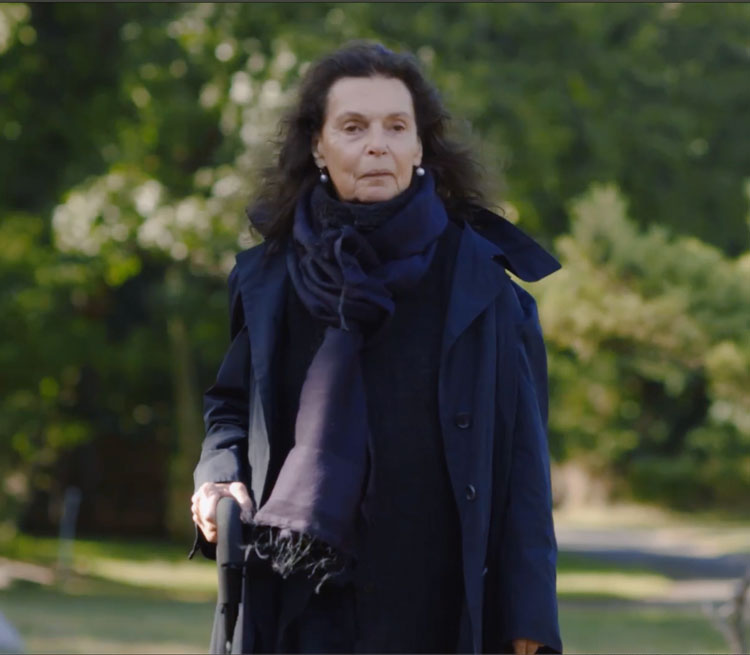
Pat Steir at Rothko’s grave. Photo courtesy Pat Steir and Veronica Gonzalez Peña.
LW: There is also a conversation between you and Sylvère Lotringer, the critic, cultural theorist and founder of Semiotext(e), another person you have been close to for decades. He said, rather adamantly, that you wanted to disappear from your work.
PS: I know what he means, but I disagree. I don’t want to disappear from my work, I’m not trying to disappear. What I’m trying to do is not tell you about my painting or what I’m feeling. I want the paint to tell me something. It’s more like researching, experimenting. I want the paint to tell me something about the nature of art, about the secret of art, the secret of nature, about the universe that we exist in. I’m not sure what that something is. Maybe everyone who makes art has the same feeling. That’s why I let the paintings make themselves.
LW: Like your Waterfalls? They are often considered the most stunning of your paintings. There is a magical photo of you in your studio where it looks as if you are creating a real waterfall. And in the film, there are some sequences of you painting that are very informative about your process, the paint coursing down the surface as you pour or apply a loaded brush, as you fling the paint, both controlling it and letting go.
PS: I started making waterfalls in the late 80s, but the first real one was made by chance in 1990. The Metropolitan has it, Sixteen Waterfalls of Dreams, Memories, and Sentiment. They are black and white but, since then, I’ve made them in a wide range of colours. They show what I mean when I say that I want the paint to make the painting, to make a picture of itself – it’s process, gravity and chance. I think of them as landscapes, but not landscapes from nature. I’m interested in Daoism, Zen painting, in the techniques and teachings of Chinese ink painting.
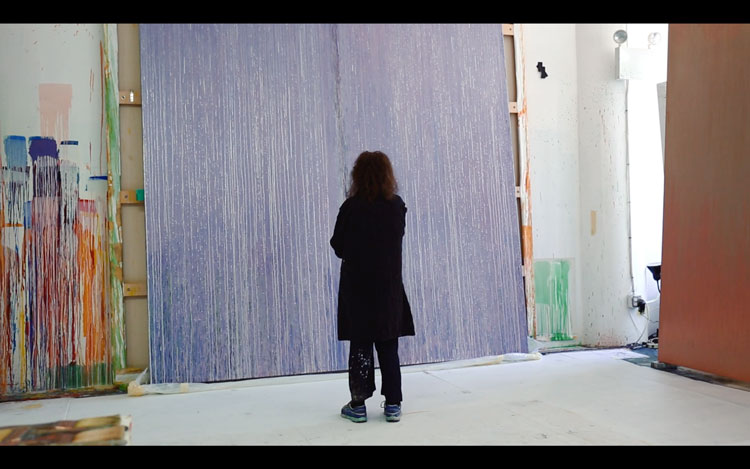
Pat Steir standing in front of Lila Judith, 2016–17. Photo courtesy Pat Steir and Veronica Gonzalez Peña.
LW: You said that you are not responsible for the painting. What do you mean by that?
PS: I mean that I don’t want to impose myself on the painting. I set some limits, but then I let go. If I did more, that would make it smaller. In the early work, I started out looking for something and I went through one phase after another, the work an addition and subtraction, a subtraction and addition. My work has always been about searching, experimenting. I have questions. I don’t have answers.
LW: How do you decide on the colours?
PS: I asked Sol a long time ago if he had a theory about colour. And he said to me, I just put one colour I like next to the other. I said, that’s what I do. I place beautiful colours next to each other.
LW: The film also talked your political leanings, about your feminism.
PS: I got involved with feminism because I’m a woman and it was in the air. Not enough had been done before and it was an active moment. Heresies was an important feminist publication and I was part of the collective that founded it. There were a number of artists, women like me, who had a great start, then a slow middle. But we are still going. And politics, civil rights. I went on marches. My first husband was drafted during the Vietnam war and we went to Atlanta, so I was there at the demonstrations and actions. John Lewis was there, Martin Luther King, so many others. They were men in suits, in dark raincoats. They were young, but they were adults, and they were very impressive, a very powerful force. Things have changed since then, but they need to change more.
LW: Can abstract work such as yours have political significance, since art, and abstract art in particular, has been shown to affect our overall cognitive state, accessing the inner regions of the brain, changing the way we perceive events and make decisions?
PS: We have to be careful how we talk about art, define art. Work that aspires to beauty has political implications, too, not just work that is terrifying and about terrifying subjects. But if you really want to be political, do as John Lewis said. Go march. Pick up people and make them march with you, now. And continue to march. Then you will have real impact.
LW: I think of you in your garden, cutting a peony from a bush and then shaking the petals, letting them fall to the ground. Gonzalez Peña shows it twice, maybe even three times, like a kind of visual motif. It seems to be about the intervention of the hand, about chance, letting go, and also a kind of metaphor for cycles and transiency, before and after the fall. I wondered why she repeated the sequence?
PS: You should ask her.
LW: I will. When someone makes a film about you, the final results might be unexpected. Were you happy with it, surprised?
PS: Yes, I was happy with the film although the whole film was a surprise. I was afraid I would be misperceived, or I would say things that would be misperceived, but Veronica is very perceptive. The biggest surprise to me was to see that I’m old now. Time doesn’t move when you do the same thing every day, so to see that you’ve become old is surprising.
LW: Well, Carmen Herrera is 105, so you have a long way to go yet.
Steir laughs.